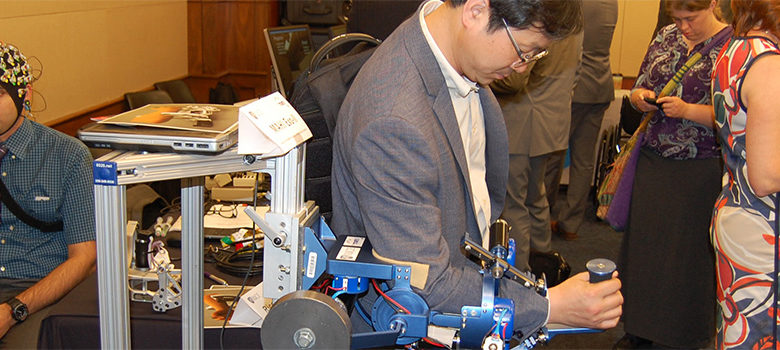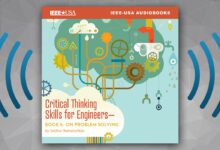
Move over, C-3PO and R2-D2! You may have been robot celebrities during the glory years of Star Wars, but next-generation robotics are the new, 21st century superstars.
Also known as “collaborative robots,” because they work beside–or cooperatively with–people, this new generation of electro-mechanical devices offers real promise in accelerating the development and use of robots in the United States. The National Robotics Initiative (NRI), which began in 2011 as a joint effort of six federal agencies (including the National Science Foundation), is spearheading the drive. Its ambitious goal is to build economic prosperity, national security and improved quality of life by supporting research that advances the usefulness of collaborative robotics–or “co-robots” as the robotics community calls them.
A recent event on Capitol Hill celebrated the five-year anniversary of the NRI. It also provided an opportunity for NRI-funded research groups to both display their accomplishments, and also encourage Congress to maintain this critical funding mechanism for robotics in the United States.

Cong. French Hill (R-Ark.) talking with Ryan Austin Reese, U.S. Navy, Ret., now Ambassador for Esko Bionics.
Sponsored by the Congressional Robotics Caucus, a bi-partisan group headed by Representative Rob Woodall, R-Ga., and Representative Mike Doyle, D-Pa., the expo offered demonstrations of innovative NRI-supported applications to an enthusiastic, daylong queue of legislators, congressional staffs, and the public. Since its inception, the Initiative has supported 231 projects totaling $153 million in awards.
“Thanks to Russell Lefevre, 2008 IEEE-USA President, we’ve been involved with the Congressional Robotics Caucus since it began,” explains Erica R. Wissolik, program manager, IEEE-USA Government Relations. “IEEE-USA has sponsored many events focusing on different areas of robotics research, industries including small businesses and start-ups, the workforce and STEM education.
“Robotics R&D is at the forefront of 21st century technology, with many opportunities for U.S. IEEE members,” she continues. “We are working to ensure they have a place at the table.” Until recently, IEEE-USA was the only technical professional organization represented in the Caucus. ASME (The American Society of Mechanical Engineers) is now a member, as well.
According to IEEE Senior Member Satyandra K. Gupta, next-generation, co-robotics increasingly are offering new advantages to industry, as well as to other key areas–like healthcare, agriculture, energy and defense. “Historically,” he says, “robots have made it easier, and/or more efficient, to handle the tasks that humans could not perform because of space limitations or, in other instances, where it simply wasn’t safe.”
Gupta, who is a professor in the Aerospace and Mechanical Engineering Department, and director of the Center for Advanced Manufacturing at the University of Southern California Viterbi School of Engineering, says the next step is to make robots easier to use–and even more efficient.
“Industry already uses robots to augment what humans do, and to work with humans side-by-side,” he says. “But issues remain with safety, and the ability to communicate with them. The NRI is helping us to resolve and realize the new vision for robotics.”
In one of the exhibits at the Congressional Robotics Caucus, Gupta and several of his team members showed visitors a small, electro-mechanical device named “Robo Raven.” Built with advanced manufacturing processes such as 3D printing and laser cutting to achieve lightweight polymer parts, the robot is distinctive for two other reasons: built-in, independent wing controls enable it to perform outdoor aerial acrobatics just like a real bird, and the wings harvest solar energy for use in tandem with the on-board battery.
The result of a decade of work, to achieve both light weight and functionality, was a major research challenge–the Robo Raven micro air vehicle (MAV) can now remain aloft for longer periods than previously possible. It shows promise for several applications, including monitoring the environment and conducting surveillance. Meanwhile, the avian-shaped robot has fooled at least one hawk, which has attacked it on several occasions.
Another exhibit at the expo featured the breakthrough work of Rice University robotics researcher Marcia O’Malley, and her collaborators at the University of Houston (UH) and University of Texas (UT) Health Science Center at Houston. Their innovative brain-machine interface promises to revolutionize upper-limb rehabilitation for stroke patients. While wearing an electrode cap that picks up electrical activity in the brain, the patient is able to operate an exoskeleton that surrounds the arm from fingertips to elbow.

An IEEE Senior Member, O’Malley is director of Rice’s Mechatronics and Haptic Interfaces Lab, which is developing the robotic exoskeleton. The UH team is working on the electroencephalograph-based neural interface, and UT physicians are testing the device on patients who volunteered to try it out.
“Although this brain-machine interface is being developed for people recovering from strokes, it also has potential to help individuals with muscular dystrophy and traumatic brain injury,” says O’Malley. Looking ahead, she predicts there could be opportunities to collaborate with NASA for eventual manned trips to Mars. “The treadmill that today’s astronauts use on the International Space Station won’t be feasible on long-duration missions because onboard space will be at a premium,” she states. “A future version of the exoskeleton–already more compact than a treadmill–could help crews to keep fit during long missions.”

Dr. Jose Luis Contreras-Vidal, Professor, University of Houston and one of Dr. O’Malley’s co-principal investigators, operating the cap on a student.
Jessy Grizzle, professor of engineering at the University of Michigan, demonstrated another type of exoskeleton development. An IEEE Fellow and an expert on bipedal robots–that is, robots that stand and walk on two legs–he and his colleagues exhibited a prototype prosthetic leg. It provides the wearer with a finer sense of balance and greater agility than current prosthetic limbs.
“It’s enormously satisfying to create the control system that enables the bipedal robot to move like the best athlete despite underactuation, unexpected impacts, or changing forces,” says Grizzle. “The human aspect, humans interacting with robots, makes the work especially exciting. So does the thrill of seeing a machine move in superhuman ways, the satisfaction of making progress, and knowing that what we’re doing will be of great benefit to people.”
He emphasizes that the bipedal robotics work underway in UM’s Control Systems Laboratory will eventually be useful in a wide range of settings–from the factory floor where robots zip around delivering parts to humans, to disaster relief where surveillance robots can inspect the area–to ensure it is safe before human rescuers enter.
USC’s Gupta, who served from 2012-2014 as an NRI program director at NSF, points out robots are “a tool to enhance human productivity.” He stresses that in industry and many other environments, using robots will lower costs while improving productivity. “In the global economy, the United States must compete effectively with lower-wage countries,” he says. “With the right balance of people and machines, we can compete with any nation–and if we don’t use robots, jobs will be outsourced elsewhere.”
Helen Horwitz is an award-winning freelance writer who lives in Albuquerque, N.M. She was with IEEE from 1991 through 2011, the first nine as staff director, IEEE Corporate Communications.






